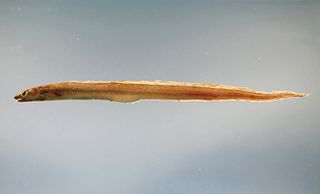
Conger is a genus of marine congrid eels. It includes some of the largest types of eels, ranging up to 2 m (6 ft) or more in length, in the case of the European conger. Large congers have often been observed by divers during the day in parts of the Mediterranean Sea, and both European and American congers are sometimes caught by fishermen along the European and North American Atlantic coasts.

The Congridae are the family of conger and garden eels. Congers are valuable and often large food fishes, while garden eels live in colonies, all protruding from the sea floor after the manner of plants in a garden. The family includes over 220 species in 32 genera.
Gnathophis umbrellabius, the umbrella conger is a conger of the family Congridae, found on soft bottoms of the continental shelf of the southwest Pacific Ocean. Length is up to 45 cm.
Bassanago is a genus of marine congrid eels.

Gnathophis habenatus, the little conger eel or silver conger, is a conger of the family Congridae, found on soft bottoms of the continental shelf of the Indian and southwest Pacific Oceans. Length is up to 43 cm.

Ariosoma is a genus of marine congrid eels.
Bathycongrus is a genus of eels in the family Congridae.
Parabathymyrus is a genus of eels in the family Congridae.

The Congrinae are a subfamily of eels in the family Congridae.
Gnathophis andriashevi is an eel in the family Congridae. It was described by Emma Stanislavovna Karmovskaya in 1990. It is a marine, deep water-dwelling eel which is known from the western part of the Sala y Gomez Ridge, in the southeastern Pacific Ocean. It dwells at a depth range of 260–330 metres. Females can reach a maximum total length of 36.5 cm.
Gnathophis bracheatopos, the longeye conger, is an eel in the family Congridae. It was described by David G. Smith and Robert H. Kanazawa in 1977. It is a tropical, marine eel which is known from the United States and the eastern Gulf of Mexico, in the western Atlantic Ocean. It dwells at a depth range of 55–110 meters. Males can reach a maximum total length of 35 centimeters.
Gnathophis castlei, or Castle's conger, is an eel in the family Congridae. It was described by Emma Stanislavovna Karmovskaya and John Richard Paxton in 2000. It is a marine, deep water-dwelling eel which is known from Queensland, Australia, in the western central Pacific Ocean. It dwells at a depth range of 131–366 metres. Males can reach a total length of 34.2 centimetres.
Gnathophis grahami, or Graham's conger, is an eel in the family Congridae. It was described by Emma Stanislavovna Karmovskaya and John Richard Paxton in 2000. It is a subtropical, marine eel which is known from New South Wales, Australia, in the southwestern Pacific Ocean. It dwells at a depth range of 50–350 metres.
Gnathophis macroporis, the largepore conger, is an eel in the family Congridae. It was described by Emma Stanislavovna Karmovskaya and John Richard Paxton in 2000. It is a marine, temperate water-dwelling eel from Victoria, Australia, in the eastern Indian Ocean. It is known to dwell at a depth of 164 metres.
Gnathophis melanocoelus is an eel in the family Congridae. It was described by Emma Stanislavovna Karmovskaya and John Richard Paxton in 2000. It is a subtropical, marine eel which is known from western Australia, in the eastern Indian Ocean. It is known to dwell at a depth of 156 metres.
Gnathophis microps, the smalleye conger, is an eel in the family Congridae. It was described by Emma Stanislavovna Karmovskaya and John Richard Paxton in 2000. It is a marine, deep water-dwelling eel which is known from western Australia, in the eastern Indian Ocean. It dwells at a depth range of 200–320 metres.
Gnathophis nasutus is an eel in the family Congridae. It was described by Emma Stanislavovna Karmovskaya and John Richard Paxton in 2000. It is a tropical, marine eel which is known from western Australia, in the eastern Indian Ocean. It dwells at a depth range of 80–140 metres.
Gnathophis parini is an eel in the family Congridae. It was described by Emma Stanislavovna Karmovskaya in 1990. It is a marine, deep water-dwelling eel which is known from the Sala y Gomez Ridge, in the southeastern Pacific Ocean. It dwells at a depth range of 540–560 metres. The maximum known total length, based on a juvenile specimen, is 13.7 centimetres.
Gnathophis smithi is an eel in the family Congridae. It was described by Emma Stanislavovna Karmovskaya in 1990. It is a subtropical, marine eel which is known from the Nazca and Sala y Gómez ridges, in the southeastern Pacific Ocean. It dwells at a depth range of 145–250 metres, and leads a nocturnal lifestyle. Males can reach a maximum total length of 41.1 centimetres. The eel's diet includes benthic crustaceans and polychaetes.
Gnathophis tritos is an eel in the family Congridae. It was described by David G. Smith and Robert H. Kanazawa in 1977. It is a marine, deep water-dwelling eel which is known from the Straits of Florida, in the western central Atlantic Ocean. It dwells at a depth range of 458–567 meters.





